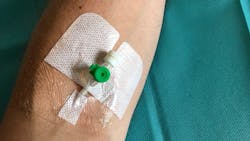Clinical trial outlines potential new best practices for peripheral IV catheters
Becton, Dickinson and Company (BD) announced that new clinical data have found robust evidence that using a vascular care solution can help improve outcomes for patients requiring peripheral intravenous catheters (PIVCs).
The results of the CLEAN3 trial1, published in The Lancet Infectious Diseases, showed the use of the BD vascular care solution resulted in fewer PIVC failures compared with the standard group (34.8 percent versus 47.5 percent, respectively) and extended the median time between catheter insertion and failure (50.4 hours versus 30.0 hours, respectively). PIVC failure was defined as any premature removal of PIVC before end of treatment – other than for routine replacement – and included phlebitis, infiltration, occlusion, dislodgment, local infection and catheter-related bloodstream infection (whichever occurred first).
The CLEAN3 trial also evaluated skin antiseptics with two percent chlorhexidine-gluconate (CHG) 70 percent isopropyl alcohol (IPA) single use, sterile applicator versus 5percent povidone iodine (PVI) 69 percent ethanol applied with sterile gauze in preventing infectious complications related to the use of PIVCs (catheter colonization: 0.9percent vs. 16.9percent, respectively; local infection: 0 percent versus 1.2 percent, respectively).
The trial, which involved approximately 1,000 patients from nine different medical wards within a single university hospital (Poitiers University Hospital, France), evaluated PIVC failure rates by comparing the BD vascular care solution for PIVCs, which included an integrated PIVC (BD Nexiva), a positive displacement needle-free connector (BD MaxZero), a disinfecting cap (BD PureHub) and a sterile prefilled flush syringe (BD PosiFlush) – compared with a standard group, which included a straight safety PIVC (BD Insyte Autoguard BC Winged), extension set three-way stopcock; the PIVCs were continuously infused with saline or polyionic solution, by gravity.
"The findings of the CLEAN3 trial support the use of an integrated solution as the best practice standard when peripheral IV catheter dwell time is expected to exceed 24 hours," said Professor Olivier Mimoz, head of the emergency department at Poitiers University Hospital, France, and principal investigator of the CLEAN3 trial. "Furthermore, the study shows that the use of two percent CHG-70 percent IPA single use, sterile applicator should become the first-line antiseptic for skin disinfection prior to PIVC insertion. We believe that the results can be extrapolated to all adult patients admitted to a medical ward requiring a PIVC placement and, by extrapolation, to those admitted to a surgical ward."
PIVCs are the most commonly used invasive medical devices in hospitals, where about two billion are placed annually worldwide. However, in hospitals, 35 percent to 50percent of PIVCs do not meet their intended dwell time and need to be removed prematurely due to preventable complications, such as infection, occlusion, phlebitis, dislodgment and infiltration. This can lead to longer hospital stays, higher inpatient costs, and greater risk of death than in patients without these preventable complications. In addition, unnecessary PIVC replacement can be painful to patients and lead to additional costs, as well as have an effect on healthcare professionals' ability to support other patients. Bloodstream infections can have an even greater impact, by prolonging hospitalization and increasing treatment costs and mortality.
